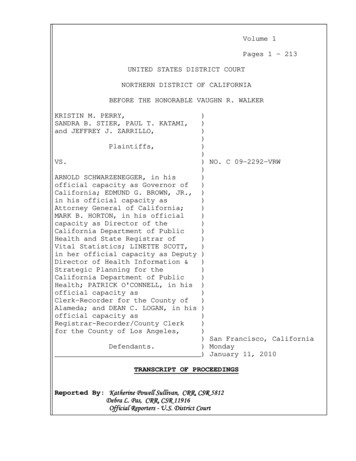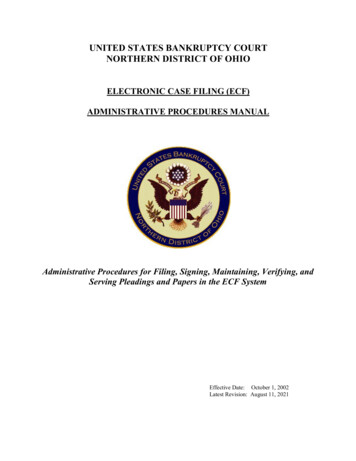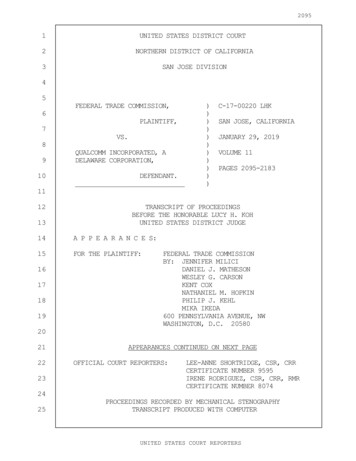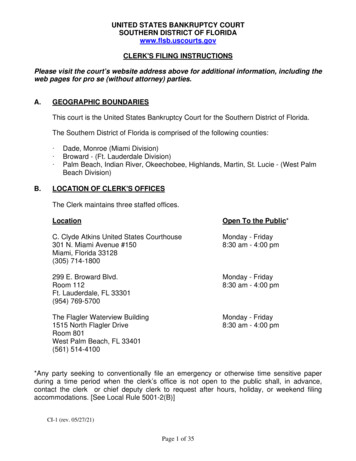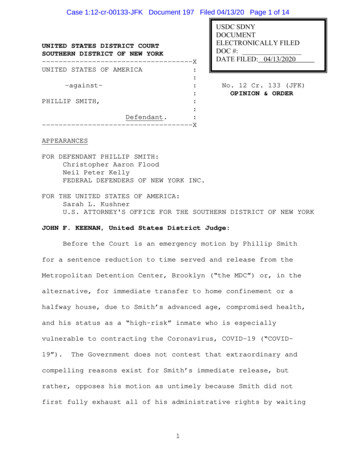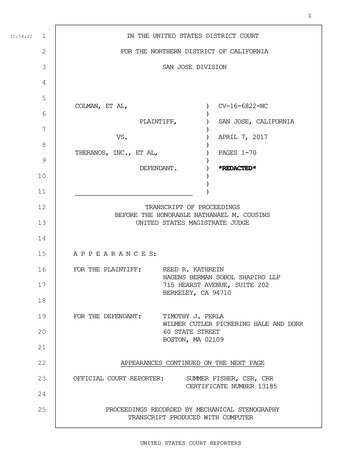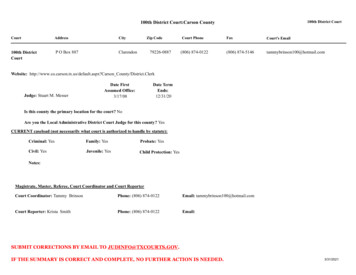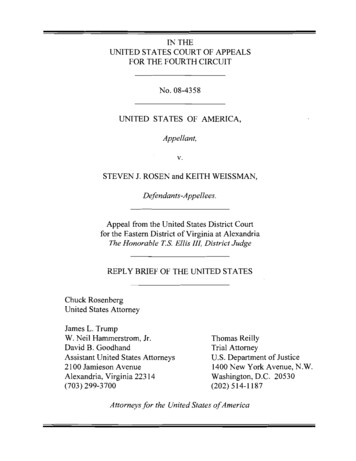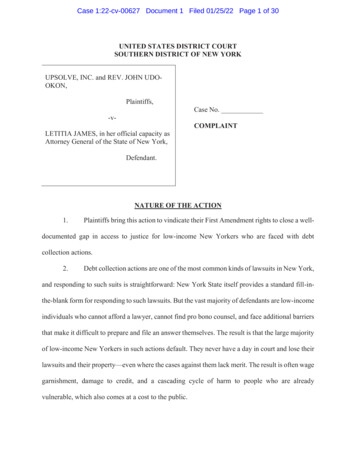
Transcription
Case 1:22-cv-00627 Document 1 Filed 01/25/22 Page 1 of 30UNITED STATES DISTRICT COURTSOUTHERN DISTRICT OF NEW YORKUPSOLVE, INC. and REV. JOHN UDOOKON,Plaintiffs,Case No.-vCOMPLAINTLETITIA JAMES, in her official capacity DVAttorney General of the State of New York,Defendant.NATURE OF THE ACTION1.Plaintiffs bring this action to vindicate their First Amendment rights to close a well-documented gap in access to justice for low-income New Yorkers who are faced with debtcollection actions.2.Debt collection actions are one of the most common kinds of lawsuits in New York,and responding to such suits is straightforward: New York State itself provides a standard fill-inthe-blank form for responding to such lawsuits. But the vast majority of defendants are low-incomeindividuals who cannot afford a lawyer, cannot find pro bono counsel, and face additional barriersthat make it difficult to prepare and file an answer themselves. The result is that the large majorityof low-income New Yorkers in such actions default. They never have a day in court and lose theirlawsuits and their property—even where the cases against them lack merit. The result is often wagegarnishment, damage to credit, and a cascading cycle of harm to people who are alreadyvulnerable, which also comes at a cost to the public.
Case 1:22-cv-00627 Document 1 Filed 01/25/22 Page 2 of 303.Plaintiffs stand ready to respond to this access to justice crisis. Plaintiff Upsolve isa nonprofit organization with a mission and a track record of fighting to ensure that all Americanscan access their legal rights. Upsolve has carefully designed, crafted, and obtained funding toimplement a program—the American Justice Movement (“AJM”)—to train professionals who arenot lawyers to provide free legal advice on whether and how to respond to a debt collection lawsuit.All advice under the program would be reliable, free, straightforward, and narrowly circumscribed,provided on a strictly non-commercial basis to ensure that defendants can understand their rightsand respond to the debt collection lawsuits against them. Plaintiff Rev. John Udo-Okon is a pastorin the South Bronx whose community is desperately in need of such free advice. Rev. Udo-Okonstands ready to associate with Upsolve to advocate for and provide free, narrowly circumscribedlegal advice for the purpose of increasing access to the courts and thereby protecting the propertyand liberty of low-income New Yorkers who are currently unable to understand or access theirlegal rights when faced with a debt collection action.4.The only thing stopping Plaintiffs is the threat of prosecution under New York’srules governing the unauthorized practice of law (“UPL”). New York law is clear that individualswho are not lawyers may not provide legal advice, and that advising a person on how to respondto a lawsuit qualifies as legal advice even when the advice is free, straightforward, and simple. TheUPL rules threaten anybody who does so—or anybody who solicits or aids in providing suchadvice—with criminal misdemeanor prosecution and civil penalties. Because AJM staff and Rev.Udo-Okon are not lawyers, they cannot provide truthful and non-misleading advice about how toanswer a debt collection lawsuit without facing the risk of such punishment.5.The UPL rules put the many low-income New Yorkers who would receive AJM’sadvice in a devastating bind. If they solicit legal advice from qualified and trusted advisors who2
Case 1:22-cv-00627 Document 1 Filed 01/25/22 Page 3 of 30are not lawyers, they face a risk of criminal or civil prosecution themselves and also expose theiradvisors to that same risk. But if they do not receive such advice, they will likely receive no adviceat all, default in their debt collection lawsuits, and face the risk of being wrongfully deprived oftheir property and the risk of harmful and long-lasting follow-on consequences.6.Plaintiffs bring this action to vindicate their First Amendment rights to close thisgap in the access to justice, and to declare that New York’s UPL rules cannot be validly applied toprohibit the truthful and non-misleading advice they would provide.7.At the outset, application of the UPL rules here triggers First Amendment scrutiny.The UPL rules are content-based because their application depends on the content of a person’sspeech, and in particular whether one individual’s speech to another includes advice about how torespond to a lawsuit. They also impede on the Plaintiffs’ associational rights, as “collective activityundertaken to obtain meaningful access to the courts is a fundamental right within the protectionof the First Amendment” to the United States Constitution. In re Primus, 436 U.S. 412, 426 (1978)(quoting United Transp. Union v. State Bar of Mich., 401 U.S. 576, 585 (1971)).8.New York’s UPL rules are well intentioned and effective at combatting the risk ofunreliable advice in many applications, so would ordinarily withstand First Amendment scrutiny.But they cannot withstand First Amendment scrutiny as applied under the narrow circumstancesof this case. As applied to Plaintiffs, those rules would be affirmatively counterproductive andimpede the very interests the UPL rules were adopted to protect. In particular, UPL rules aredesigned to protect consumers from unreliable or fraudulent advice and to protect the integrity ofthe courts and the public perception of the justice system. But Plaintiffs would be providing advicefor free, without any financial motivation. They would be advising individuals in an area whereNew York has itself recognized an access to justice gap and that straightforward advice can be3
Case 1:22-cv-00627 Document 1 Filed 01/25/22 Page 4 of 30reliably provided, as New York promulgates a standard form for filing such a response. AndPlaintiffs have carefully crafted their program to ensure reliability—with third-party expertsattesting that the program would help many New Yorkers. Conversely, without the free adviceprovided under Plaintiffs’ program, many low-income New Yorkers would be left to fend forthemselves without any advice at all about how to respond to a debt collection action: Low-incomeNew Yorkers typically cannot afford a lawyer, especially to respond to relatively low-dollardemands, and pro bono counsel are in too short supply to fill the gap. Experience shows that manyindividuals will simply fail to respond, leading to default judgments entered without anyadversarial testing, notwithstanding evidence that debt collection suits often lack merit or demandinflated payments. New York does not have a legitimate interest in increasing the number ofdefault judgments and preventing people from obtaining help to respond to lawsuits using a formthat New York has itself provided, particularly when Plaintiffs have carefully crafted a program toprovide the requisite protections against uninformed, bad-faith, or false advice.9.This Court accordingly should enter a declaration that the UPL rules areunconstitutional as applied to Plaintiffs’ participation in the American Justice Movement, and aninjunction preventing the enforcement of the UPL rules against Plaintiffs’ conduct, along withother relief necessary for Plaintiffs to vindicate their constitutional rights.THE PARTIES10.Plaintiff Upsolve, Inc., is a 501(c)(3) nonprofit, tax-exempt organization charteredin New York with the mission of helping Americans access their civil legal rights for free andengaging in widespread education and advocacy to that end. Upsolve is currently the largestnonprofit organization providing free bankruptcy-related resources in the United States and hasconfirmed relieving more than 400 million in debt for low-income self-represented debtors filingfor simple, no-asset Chapter 7 bankruptcy. Upsolve also provides free online education on a4
Case 1:22-cv-00627 Document 1 Filed 01/25/22 Page 5 of 30number of topics, including debt collection defense, student loans, wage garnishment,repossession, foreclosures, evictions, among others, and serves over 150,000 individuals permonth. Coupled with its free online resources, Upsolve invests heavily in public advocacy to raiseawareness around civil rights injustices, and the corresponding inability of millions of low-incomefamilies to access their legal rights.11.Upsolve’s success has been widely recognized in the media. Upsolve has receivedfunding support from major public-interest and philanthropic organizations, such as the RobinHood Foundation and the Hewlett Foundation.12.The American Justice Movement is an Upsolve project.13.Plaintiff Reverend John Udo-Okon is a reverend at Word of Life ChristianFellowship International in the South Bronx. Rev. Udo-Okon and his congregation provideservices to people in need. Many members of his community are facing credit issues and debtcollection lawsuits and lack access to free counsel or legal advice they can afford.14.Defendant Letitia James is the Attorney General of the State of New York.Defendant James’ official duties include the administration and enforcement of regulationsgoverning the unauthorized practice of law. She is sued in her official capacity.JURISDICTION AND VENUE15.This Court has jurisdiction pursuant to 28 U.S.C. § 1331 and 28 U.S.C. § 1343because this suit arises under the First and Fourteenth Amendments to the United StatesConstitution and 42 U.S.C. § 1983. This Court also has jurisdiction under the DeclaratoryJudgment Act, 28 U.S.C. §§ 2201–02.16.Venue is proper in this judicial district pursuant to 28 U.S.C. § 1391(b)(2) becausea substantial part of the events giving rise to the claim have occurred or will occur in this judicialdistrict.5
Case 1:22-cv-00627 Document 1 Filed 01/25/22 Page 6 of 30FACTSI.Many New Yorkers lack the basic legal assistance they need to respond to debtcollection lawsuits, which can result in severe long-term consequences.17.The problem Plaintiffs seek to solve is widespread and severe: A restricted supplyof free or low-cost civil legal assistance prevents low-income New Yorkers from understandingand accessing their legal rights when they are faced with debt collection actions, leading towrongful deprivations of property and a cascade of other life-altering consequences.18.Debt collection actions are one of the most common kinds of lawsuit in New YorkState courts. Debt collection actions have been estimated to comprise approximately one quarterof all lawsuits in New York’s courts.19.In the vast majority of debt collection lawsuits in New York State, the defendantfails to appear and thus faces a default judgment. Some estimates put this rate of default as high as85-90%. A lower range of estimates puts it closer to 70%. Either way, the large majority of debtcollection lawsuits end with a default judgment.20.Defendants can avoid a default judgment, and the adverse consequences flowingfrom such a judgment, only if they file a timely response to the debt collection action.21.Defendants who respond to debt collection lawsuits often obtain better outcomes,because many debt collection lawsuits lack merit or demand an amount that is too large. Forexample, one study by the Legal Aid Society of New York reviewed a sample of debt collectioncases and estimated that more than a third were “clearly meritless.”11The Legal Aid Society et al., Debt Deception: How Debt Buyers Abuse the Legal System toPrey on Lower-Income New Yorkers, at 8–10 & 26 n.91 (May 2010), 014/08/DEBT DECEPTION FINAL WEB-new-logo.pdf.6
Case 1:22-cv-00627 Document 1 Filed 01/25/22 Page 7 of 3022.By failing to answer and to assert available affirmative defenses, many defendantsare deprived of their property without ever having their day in court. When defendants default,plaintiffs never have any need to prove their cases, and courts have no opportunity to assess themerits of their claims, even when a claim would fail were it subjected to adversarial testing.23.Adverse judgements in debt collection actions can have devastating effect on thelives of low-income New Yorkers.24.Defaulting in a debt collection lawsuit can lead to wage garnishment, eviction,repossession of an automobile, bank seizures, and lasting damage to a consumer’s credit. Thisdamage to credit can make it difficult for low-income New Yorkers to secure future financing—such as on a car they need to access employment opportunities—and can make it more difficultfor them to rebuild their credit. For somebody living in precarious financial circumstances, evensmall-dollar lawsuits can snowball to have devastating consequences.25.The stories of New Yorkers William Evertsen, Liz Jurado, and Christopher Lepre—all of whom defaulted in debt collection actions in which they received no legal advice—demonstrate the need for such advice and the serious long-term consequences New Yorkers canexperience without it2:xWilliam Evertsen: William (“Tyler”) Evertsen is a 60-year-old HIV-positive gay manliving in Brooklyn. In 2017, Evertsen received harassing phone calls from a third-partydebt buyer regarding a debt he did not owe. The third-party debt buyer sued him and gota default judgment against him for this debt he did not owe, which has contributed to hisfinancial distress. Evertsen explained that “[t]he judgment made me feel like I wasdefrauded, because they never proved that I actually owed the debt [and] I was alsopowerless to do anything about it.”xLiz Jurado: In 2019, after her husband lost his job, Liz Jurado got a full-time job thatwould allow her to “provide for my kids and take care of my husband.” But shortly2Declarations from these three individuals describing their experiences are attached to theSilbert Declaration in Support of the Motion for a Preliminary Injunction. See Silbert Decl. Ex. 5(Evertsen); Ex. 6 (Jurado); Ex. 7 (Lepre).7
Case 1:22-cv-00627 Document 1 Filed 01/25/22 Page 8 of 30thereafter Jurado received a letter from the sheriff that they were going to garnish herwages because she had defaulted in a lawsuit to collect a surprise medical debt incurredin connection with the birth of one of her children. Jurado “knew that having my wagesgarnished would have severe effects for myself and my family” since they “were livingpaycheck-to-paycheck.” Jurado received no legal advice because she “could not afford alawyer” and “did not know of any resources that would provide me with legal assistancefor free.” As Jurado describes her experience, “I was facing permanent, life-alteringconsequences for something that I didn’t even know how to do anything about.”xChristopher Lepre: In 2015, Christopher Lepre’s car flipped over. Lepre, a U.S. Navyveteran, had “no choice but to take on a high interest loan” to purchase a new car.Lepre’s car quickly stopped working. Lepre’s auto lender demanded repayment, suedhim on his debt, and he defaulted because he “didn’t know what I needed to do in orderto defend myself” and was unable to find a lawyer to help him. As Lepre explains, “Iwish I had gotten my day in court . . . [but] the judge decided the case without hearingmy side and without the [other side] ever having to prove their case.” Lepre continues tosuffer the “negative consequences of the lawsuit”: his wages are being garnished at therate of over 1000 per month; there were times he “could not afford to pay [his] rent”; he“cannot afford a car”; and his credit score is “further damaged.”26.Access to basic free legal advice could make a big difference for many other debtcollection defendants. Individual defendants who have legal assistance not only have their day incourt, but also tend to secure more favorable outcomes. As a report from the National Center forState Courts explains: “Although plaintiffs are generally represented by attorneys, defendants in[lower-value] cases are overwhelmingly self-represented, creating an asymmetry in legal expertisethat, without effective court oversight, can easily result in unjust case outcomes.”327.There is accordingly a pressing need among many low-income New Yorkers forlegal advice about how to respond to a debt collection action to avoid a default judgment, obtainaccess to justice, and potentially obtain a better outcome by prevailing on the merits.3National Center for State Courts, Call to Action: Achieving Civil Justice for All, at 34 (2016),https://www.ncsc.org/ data/assets/pdf file/0029/19289/call-to-action -achieving-civil-justicefor-all.pdf; see also The Pew Charitable Trusts, How Debt Collectors Are Transforming theBusiness of State Courts, at 14–15 (May 2020), bt-collectors-to-consumers.pdf (collecting “analyses from jurisdictionsacross the country indicat[ing] that when consumers are represented by attorneys, they are morelikely to secure a settlement or win the case outright”).8
Case 1:22-cv-00627 Document 1 Filed 01/25/22 Page 9 of 3028.Despite this need for legal assistance, the vast majority of debt collectiondefendants in New York lack legal representation and many face default judgments as a result.Many low-income debt collection defendants cannot afford to pay for a lawyer to represent themin their case. And free lawyers are in too short supply to meet the immediate needs of manyindividuals in low-income communities.29.As a 2010 report by the Federal Trade Commission (“FTC”) explained: Although“[f]undamental fairness dictates that the legal process afford consumers a reasonable opportunityto defend themselves[,]” “[m]ost alleged debtors fail to answer complaints or otherwise defendthemselves in debt collection actions.”4 The FTC Report went on to note that “[t]here [is] broadconsensus . . . that relatively few consumers who are sued for alleged unpaid debts actuallyparticipate in the lawsuits,” and cited estimates that “sixty percent to ninety-five percent ofconsumer debt collection lawsuits result in defaults.”530.The rate of default is particularly high among communities of color. A study ofjudgments over a five-year period in St. Louis, Chicago, and Newark, New Jersey, found that, even4Federal Trade Comm’n, Repairing a Broken System: Protecting Consumers in Debt CollectionLitigation and Arbitration, at 6–7 (July 2010), ecting/debtcollectionreport.pdf.5Id. at 7; see also, The Aspen Institute Financial Security Program, Aspen Inst., A FinancialSecurity Threat in the Courtroom: How Federal and State Policymakers Can Make DebtCollection Litigation Safer and Fairer for Everyone, at 8 (Sept. 2021) (“Multiple studies haveshown that more than 70 percent of debt collection lawsuits end in default judgments in thestudies jurisdictions. This is despite the fact that the individuals being sued may have legitimatedefenses.”) 2021/09/ASP-FSP DebtCollectionsPaper 092221.pdf.9
Case 1:22-cv-00627 Document 1 Filed 01/25/22 Page 10 of 30after accounting for income, the rate of default judgments in mostly black neighborhoods wasnearly double that of mostly white ones.631.This high rate of default—which means that plaintiffs never have to prove theircases—is particularly problematic because many debt collection suits lack merit.32.A study by the Legal Aid Society of New York found that, in more than a third ofa sample of debt collection cases reviewed, “the debt was the result of mistaken identity or identitytheft, the debt had been previously paid, the debt had been discharged in bankruptcy, or the statuteof limitations on the debt had expired.”7II.New York provides a form for responding to a debt collection action, but many lowincome New Yorkers are unable to use it.33.Responding to a debt collection lawsuit in New York is typically straightforwardand does not require significant specialized legal training. Law school, however, takes three yearsand often comes at a significant cost.34.Indeed, New York State has provided a fill-in-the-blank answer form for debtcollection defendants that allows them to respond to lawsuits and raise common defenses,asserting, for example, that they do not owe the debt, the amount is inaccurate, or the lawsuit isoutside the statute of limitations.8 A copy of the form is attached as Exhibit A to this complaint.6Paul Kiel and Annie Waldman, The Color of Debt: How Collection Suits Squeeze BlackNeighborhoods, ProPublica (Oct. 8, 2015), lawsuits-squeeze-black-neighborhoods.7Legal Aid Society et al., supra note 1, at 10, 26 n.91.8See New York State Unified Court System, Answer Form, nsumer-Credit-Answer.pdf; see also New York State Unified Court System,Common Defenses in a Debt Collection Case (describing common affirmative defenses that canbe raised on the Answer Form), efenses.shtml (last updated March 14, 2018).10
Case 1:22-cv-00627 Document 1 Filed 01/25/22 Page 11 of 3035.The one-page form is simple. Its heading provides labeled blank spaces in which towrite the caption of the action. After that, the form offers a series of 24 labeled checkboxes thatcan be checked to raise particular defenses, for example, “I have paid all or part of the allegeddebt” or “I had no business dealings with Plaintiff (Plaintiff lacks standing).” One of thecheckboxes is labeled “Other Reasons” and provides a blank space in which additional answerscan be written. The bottom of the form allows for verification and notarization.36.In providing this form, New York itself thus recognizes that the practicalimportance of responding to a debt collection action and that doing so is typically straightforwardand simple.37.New York’s form is inadequate, however, to close the gap in the access to justice.38.Even with this form, the large majority of low-income New Yorkers fail to respondto debt collection actions, or fail to do so accurately, and accordingly face default judgments.39.The high default rate despite the availability of New York’s answer form confirmsthat barriers of legal complexity and fear (among others) prevent low-income New Yorkers fromvindicating their rights on their own.40.For example, New York’s form includes language that requires some measure offamiliarity with the legal system and specialized terminology, which many low-income defendantslack. Among the checkboxes that the answer form offers are: “General Denial: I deny theallegations in the Complaint”; “I received the Summons and Complaint, but service was not correctas required by law”; “Unconscionability (the contract is unfair)”; “Statute of limitations (the timehas passed to sue on this debt)”; “Unjust enrichment (the amount demanded is excessive comparedwith the original debt)”; and “Laches (plaintiff has excessively delayed in bringing this lawsuit to11
Case 1:22-cv-00627 Document 1 Filed 01/25/22 Page 12 of 30my disadvantage).”9 Many low-income New Yorkers are unfamiliar, however, with concepts of ageneral denial, the requirements of service of process under law, the meaning of unconscionability,the applicable statute of limitations to a debt collection action, or the application of laches in a debtcollection suit.41.Low-income defendants often face language barriers and literacy and educationalgaps. They also typically lack familiarity with the civil justice system and are often intimidatedby, or anxious and uncertain about how to respond, when served with a debt collection lawsuit.Many people thus do not understand how the civil legal system works, much less how to respondto a lawsuit to defend their own rights, or are apprehensive to do so.42.What scholars have called the “costs of financial misery”—which cause people to“work overtime, forego basic necessities, face serious health consequences, deal with persistentdebt collection calls, end up in court, lose homes, and sell what little they own”—further increasethe barriers low-income New Yorkers face in vindicating their legal rights.10 As the high rate ofdefault indicates, especially when coupled with the high number of meritless collection actions,more assistance is needed to ensure that all New Yorkers are able to participate in the legal systemand vindicate their rights in court.43.Low-income New Yorkers faced with debt collection lawsuits often cannot affordto hire paid counsel to represent them.44.Some attorneys provide free legal counsel, including for responding to debtcollection actions. But the availability of free assistance from barred lawyers is in too short supply9New York State Unified Court System, Answer Form.10Pamela Foohey, Robert M. Lawless, Katherine M. Porter & Deborah Thorne, Life in theSweatbox, 94 Notre Dame L. Rev. 219, 255 (2018).12
Case 1:22-cv-00627 Document 1 Filed 01/25/22 Page 13 of 30to satisfy the demand. One study estimated that the leading nonprofit program in New York Cityfor debt collection defense had the resources to assist fewer than 2% of all individuals sued on adebt in New York City Civil Court.1145.There is a constitutional right to free counsel is criminal cases, but no such rightattaches in civil debt collection actions.46.Attorneys who provide free or low-cost services to debt collection defendants arefrequently overloaded and often cannot provide enough assistance on the quick timeline on whichsuch suits proceed.47.The result is that most low-income New Yorkers facing debt collection lawsuits areleft without any representation at all, and instead must fend for themselves. By many estimates,over 90% of defendants in debt collection lawsuits—and by some estimates up to 99%—are leftwithout any representation and must fend for themselves.1248.This problem has been exacerbated by the pressures of COVID-19, as a number offree legal aid programs have been curtailed due to the constraints of the pandemic. For example,New York’s Civil Legal Advice and Resource Office (“CLARO”) cancelled all in-personprogramming until further notice, due to the COVID-19 pandemic.13 Additionally, the New YorkState Courts’ Volunteer Lawyer for a Day Program—a program where which volunteer attorneys11Legal Aid Society et al., supra note 1, at 17.12The Pew Charitable Trusts, supra note 3, at 13–14.13CLARO, COVID-19 Notice, http://www.claronyc.org/claronyc/default.html (last visited Jan.20, 2022).13
Case 1:22-cv-00627 Document 1 Filed 01/25/22 Page 14 of 30provide limited representation for unrepresented consumer debtors in state court in New YorkCity—is now operating virtually and on a limited basis in some counties.1449.The lack of representation for debt collection defendants is often contrasted withsophisticated representation on the plaintiff side.50.In its November 2020 annual report, the State of New York’s PermanentCommission on Access to Justice stated that “high-volume debt collection cases with frequentdefaults” are “notorious for having over-zealous plaintiff attorneys and largely unrepresenteddefendants.”1551.Because creditors often have (and debt buyers can purchase) large books of similardebts, they can take advantage of economies of scale to bring many lawsuits at a lower cost andpursue actions even for small-dollar debts. The high rate of defendant default means that creditorplaintiffs will rarely have to prove their cases in court, creating a disincentive to invest theresources to investigate potential actions thoroughly before filing lawsuits. Individual defendants,by contrast, are faced only with a single suit—sometimes demanding less money than it wouldcost to hire a lawyer to defend the suit—and cannot take advantage of economies of scale. Theyinstead face transaction costs that are effectively insurmountable for many low-incomeindividuals, contributing to the high rate of default judgments. Absent free or low-cost legal advice,this asymmetry can have the effect of preventing low-income New Yorkers from defending theirproperty against wrongful deprivation in a manner that is economically rational.14New York State Unified Court System, Access to Justice Volunteer Attorney er/VAP/program descriptions.shtml (last visited Jan.20, 2022).15Permanent Comm’n on Access to Justice, Report to the Chief Judge of the State of New York,at 10 (Nov. 2020), ecommission/20 ATJComission Report.pdf.14
Case 1:22-cv-00627 Document 1 Filed 01/25/22 Page 15 of 3052.The ability to bring a high number of cases with confidence that many defendantswill default and the merits of the cases will never be examined also creates a risk of fraud andabuse of the legal process and in the origination of the loans whose collection ultimately results insuch default judgments. For example, one process server in New York State pleaded guilty to fraudin connection with a failure to properly notify debt collection defendants that led to approximately100,000 improper default judgments.16 And the New York Attorney General and other stateAttorneys General have investigated the origination and collection practices of lenders inconnection with potential violations of federal and state consumer protection laws.1753.Debt collection lawsuits are emblematic of a broader access to justice gap thatprevents low-income New Yorkers from understanding and accessing their civil legal rights.54.As the American Bar Association has concluded, “[d]espite sustained efforts toexpand the public’s access to legal services, significant unmet needs persist.”18 In a single year in16N.Y. State Off. of the Att’y Gen., The New York State Attorney General Andrew M. CuomoAnnounces Guilty Plea Of Process Server Company Owner Who Denied Thousands Of NewYorkers Their Day In Court (Jan. 15, 2010), plea-process.17See, e.g.
21. Defendants who respond to debt collection lawsuits often obtain better outcomes, because many debt collection lawsuits lack merit or demand an amount that is too large. For example, one study by the Legal Aid Society of New York reviewed a sample of debt collection cases and estimated that more than a third were "clearly meritless."1
